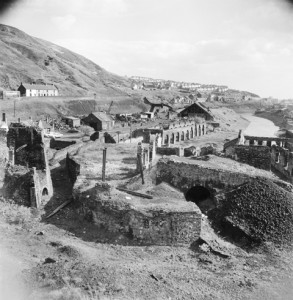View of the White Rock site taken from near what is now the hill next to the current car park. There is much of interest here. The tall structure in the middle left of the photo is close by the canal basin and formed part of the support for the railway incline and flue chimney which went up the side of Kilvey Hill. Only the lower section remains, which also contains an archway appearing to descent underground. Whether this was a kiln, furnace or part of the flue system is uncertain. Just across the pathway is the wall of a higher section which once carried a railway. Some of the four metal pillars which supported the incline at this point can still be seen. To the right of these is the start of the lower ramp of the incline. Under this is a brick archway which contains two bricked-up portals which lead directly to a chimney which is built into this part of the ramp.
Going across the centre of the photo from left to right are the entrance offices (partly obscured by the incline support structure, the masonry of which forms the northern portal of the canal tunnel and over which was one of the work’s main entrances). Looking carefully at the right hand wall of the pathway there is a notch where a railway bridge brought wagons into this section of the works. The ground appears to be the first floor of a building of unknown function, the external walls of which are visible beside the top of the ramp. On the right middle of the picture just below the river meandering into the distance are the remains of two further buildings which once contained furnaces.
Again traversing the photo a little further up are stores. The long arched structure was part of the ‘Great Workhouse’ which formed the main smelting hall of the original plant.
Finally, just above the centre of the photo are the entrance bridge over the railway coming up from Swansea St Thomas station, and one of the last buildings to be constructed on the site which is thought to have been a sheet lead plant. Towards the end of its life, the section from the stores to the lead sheet plant was apparently used as a scrap yard, the old railway loop and sidings being barely visible on later photos due to the piles of old vehicles and scrap.
Photograph © Crown copyright: Royal Commission on the Ancient and Historical Monuments of Wales

